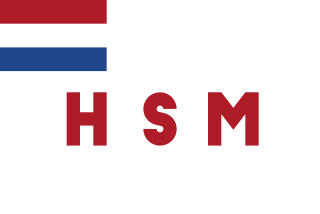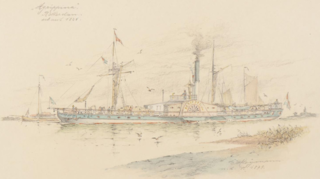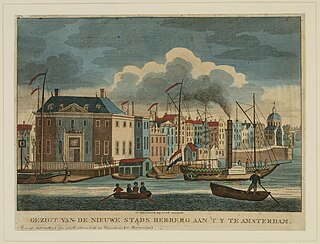
A steamship, often referred to as a steamer, is a type of steam-powered vessel, typically ocean-faring and seaworthy, that is propelled by one or more steam engines that typically move (turn) propellers or paddlewheels. The first steamships came into practical usage during the early 1800s; however, there were exceptions that came before. Steamships usually use the prefix designations of "PS" for paddle steamer or "SS" for screw steamer. As paddle steamers became less common, "SS" is assumed by many to stand for "steamship". Ships powered by internal combustion engines use a prefix such as "MV" for motor vessel, so it is not correct to use "SS" for most modern vessels.

A paddle steamer is a steamship or steamboat powered by a steam engine that drives paddle wheels to propel the craft through the water. In antiquity, paddle wheelers followed the development of poles, oars and sails, where the first uses were wheelers driven by animals or humans.
HMS Western Isles was a command ship of the Royal Navy during World War II, serving as the flagship of the Anti-Submarine Training School at Tobermory on the Isle of Mull under Vice Admiral Gilbert Stephenson. Launched in 1902 as the Dutch Batavier Line passenger ship Batavier IV, after the war she served in the Royal Netherlands Navy as the training ship Hr. Ms. Zeearend. She was decommissioned in 1970, and scrapped in 1972.
Aktien-Gesellschaft Vulcan Stettin was a German shipbuilding and locomotive building company. Founded in 1851, it was located near the former eastern German city of Stettin, today Polish Szczecin. Because of the limited facilities in Stettin, in 1907 an additional yard was built in Hamburg. The now named Vulcan-Werke Hamburg und Stettin Actiengesellschaft constructed some of the most famous civilian German ships and it played a significant role in both World Wars, building warships for the Kaiserliche Marine and the Kriegsmarine later.
Köln-Düsseldorfer (KD) is a river cruise operator based in Cologne, Germany. The company operates a total of 14 cruise ships on the Rhine, Main and Moselle rivers. The famous KD steamer line operated on the Rhine with steamers and tourist boats. The Lorelei rock was a famed day outing for pleasure seekers.

SS Batavier II was a steam packet for the Batavier Line that sailed between Rotterdam and London for most of her career. The ship was built in 1897 by the Gourlay Brothers of Dundee. The Dutch ship could carry a limited amount of freight and up to 321 passengers. She was rebuilt in 1909 which increased her length by over 5 metres (16 ft).
SS Batavier II may refer to one of the following ships of the Batavier Line:
SS Batavier V may refer to one of the following ships of the Batavier Line:

SS Batavier V was a steam packet for the Batavier Line that sailed between Rotterdam and London for most of her career. The ship was built in 1897 by the Gourlay Brothers of Dundee. The Dutch ship could carry a limited amount of freight and up to 428 passengers. She was rebuilt in 1909 which increased her length by over 5 metres (16 ft).
The River Dart Steamboat Co Ltd (RDSC) and its predecessors, the Dartmouth Steam Packet Company and the Dartmouth and Torbay Steam Packet Company, were the major ferry and excursion boat operators on the River Dart in South Devon for 120 years, until the company's demise in 1976. The company was famous for its distinctive paddle steamers, which were a familiar sight on the river until the late 1960s.

Regie voor Maritiem Transport (RMT) was the Belgian state-owned ferry service and operated ferries on the Ostend-Dover route under the name Oostende Lines. For the last few years until its demise in February 1997, the ferries from Ostend went to Ramsgate instead of Dover in partnership with Sally Line.
Theresia L M Russ was a 1,694 GRT cargo ship that was built in 1927 by Neptun AG, Rostock, Germany for Ernst Russ. She was requisitioned by the Kriegsmarine for two years during the Second World War. In 1944, she was sunk by bombing at Gotenhafen, German occupied Poland. The ship was raised and repaired in 1945. She was seized by the Allies at Copenhagen and passed to the Ministry of War Transport (MoWT) and renamed Empire Concrete.
Associated Humber Lines (AHL) was created in 1935 to manage the services of various railway controlled shipping lines including port activities in the Humber area of the United Kingdom. The ownership of the respective vessels did not transfer to A.H.L and similarly the ports concerned, Hull, Goole and Grimsby, also remained under the control of the railway companies and their successors.

The Holland Steamship Company was formed in Amsterdam in 1885 to run a steamship service from Amsterdam to London.

The General Steam Navigation Company (GSN), incorporated in 1824, was London's foremost short sea shipping line for almost 150 years. It was the oldest shipping company in the world to begin business with seagoing steam vessels.

Fijenoord was a shipbuilding company and machine factory in Rotterdam the Netherlands from 1823 to 1929. In 1929 it merged with Wilton to become Wilton-Fijenoord.

The Nederlandsche Stoomboot Maatschappij ( ), abbreviated as NSM or NSBM, was a Dutch shipping line focused on inland navigation. In the 1820s it was important for the quick introduction of steam power on the Dutch rivers and on the Rhine. NSM owned the major shipbuilding company Fijenoord.

Agrippina was a steamboat designed for the Middle Rhine. On delivery she was found to be too heavy, and was returned to her builder NSM, which tried to use her as a freighter on the Lower Rhine. When this failed too, Agrippina's engines were used to create the compound steam engine of the tugboat Hercules, creating the first effective compound steam engines. In 1829 Agrippina was the first towed dumb barge on the Rhine. After a rebuilt, she became the first steamboat to tow an iron barge on the Rhine in 1841.

SS De Batavier, launched in 1827 was an early steamship which served on the Rotterdam to London line of the Nederlandsche Stoomboot Maatschappij (NSM). As such she was in news quite often, but the Batavier also appeared in fiction and non-fiction. The Batavier is the location of a chapter of Thackeray's Vanity Fair.

Amsterdamsche Stoomboot Maatschappij was an early Dutch steam shipping company.













